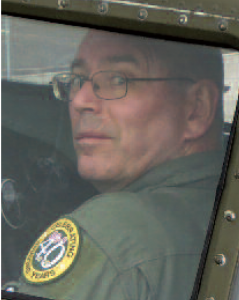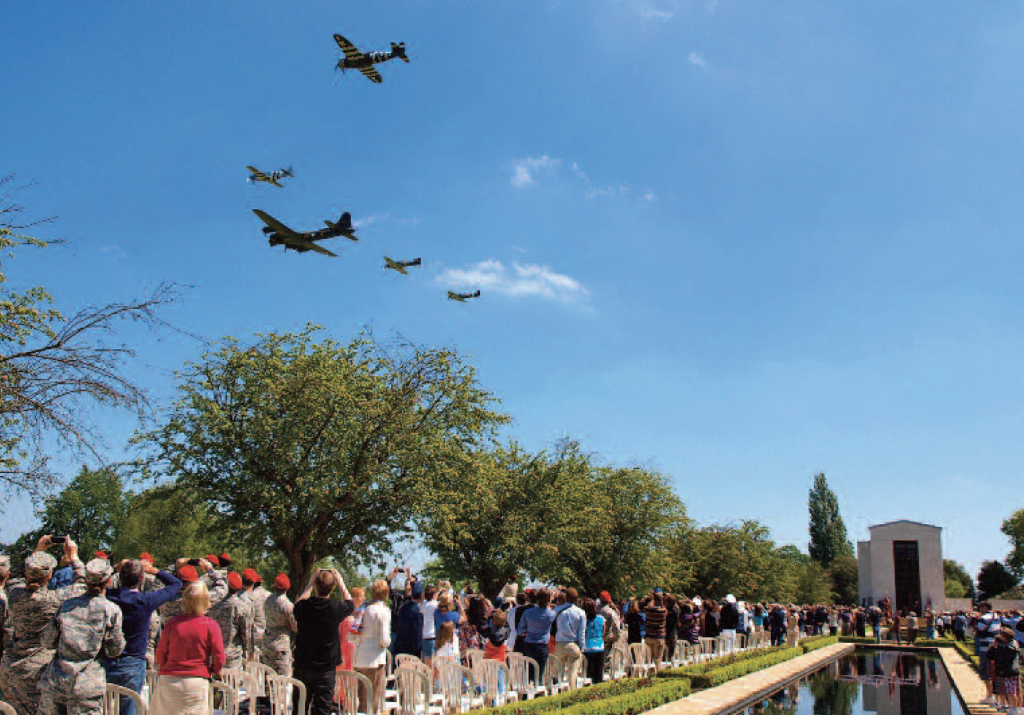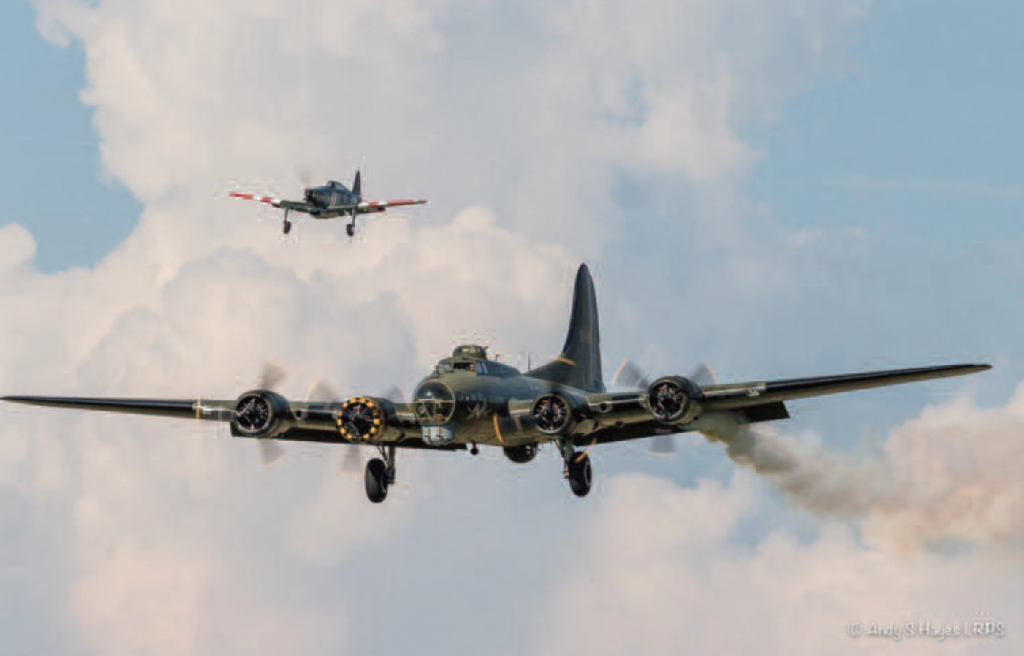By Captain Peter Kuypers
My involvement with Sally B began at the end of the 2009 season when Elly Sallingboe asked me if I was interested in flying Sally B (actually she told me that I had to and she was not taking no for an answer).
Of course, I was not going to let this unique opportunity pass me by, especially as my previous warbird experience meant that I fitted the pilot’s profile well. I had been flying the Netherlands Air Force Historic Flight B25 Mitchell bomber and also DC3 transports for almost 20 years, and had even flown formation in a B25 with Sally B during a VE day flypast over Buckingham Palace.
Training Began Not long after, I had my first flight in a B-17, this was as an observer on a flight to the Bournemouth Air Festival, where I saw what flying this aircraft was all about.
My training began in May 2010 with Andrew Dixon as my instructor, and after a thorough review of the aircraft’s systems and of normal and emergency procedures, I strapped into the righthand co-pilots seat and we started all four engines. On the B-17 the captain always sits on the left and the co-pilot or student sits on the right. I do not know where this comes from, but, this custom has been carried forward to all modern aircraft like Boeing and Airbus, only helicopters are the other way around.

We fly the B-17 as a team with the captain, co-pilot, and engineer, each having his own tasks. During engine starting the co-pilot activates the engine starters whilst the captain introduces the fuel. The engineer watches out for failures and fires. During initial take-off, the captain handles the outboard engines and the co-pilot the inboard engines. The whole choreography of how we fly this aircraft is written down in our handling notes.
We went to Cambridge airport for our training flight for safety reasons as the runway there is a bit longer than at Duxford, and soon after I was flying around the circuit at Cambridge to practice landing and take-offs, this is called touch and go training. The next step was engine failure procedures where we simulate an engine failure by retarding the power on one engine followed by the emergency drills. The single-engine failure (in pilot’s speak called a N-1) is a simple failure on the B-17, as a pilot you can feel that this aircraft was designed to take a lot of (battle) damage. The double engine failure (called a N-2) even with the affected engines on the same side felt a bit like flying a DC3 on one engine, meaning controllable and slow climbing but safe.
After being given my CAA B-17 type rating exemption I was ready to start my first B-17 season. My very first flight after training was to the Danish Airforce air show at Skrydstrup in 2010. Roger Mills was captain, and I was the co-pilot. The crowds waiting for us at various places were amazing, and Roger and Sally B won the prize for best display.
The following year in 2011, I was given the chance to become captain on the B-17. The training was again at Cambridge, but this time I was in the left seat and my instructor Andrew Dixon in the right seat. Andrew did give me a lot more engine failure training this time!
My memorable flights
Many more flights followed, some do stand out more than others. The first that comes to mind is the “Eagle Flight” on Memorial Day in May 2013 which was a formation flight over several 8th Airforce bases in East Anglia.
The flight was to commemorate the American Airforce’s entry into WWII in 1943. I was leading the big formation in Sally B and had with me four little friends (P51 Mustang, P47 Thunderbolt, Spitfire and Hurricane). We began by overflying the Madingley Cemetery at low level before continuing. A small course correction at the last minute dislodged the P47 slightly but American Steve Hinton is a brilliant pilot and no-one hopefully noticed, but I almost missed Madingley.

Another memorable flight was to Payerne, Switzerland in 2014 with Daryl Taplin as co-pilot.
The show commemorated 100 years of the Swiss Airforce, and it stands out due to the extravagant and well organised displays and because we re-enacted a WWII scenario where the B-17 was being forced to land after being shot at by a Swiss Morane fighter.
We used our smoke system to simulate this but also had the wheels down to land, probably the only picture where we have smoke on and wheels down.

In June 2017 I was Captain for the RAF Cosford air show with fellow captain Roger Mills when suddenly during my display a large B52 USAF bomber showed up for its display too early. Because the Americans were on another frequency, they could not be warned off as they entered my display arena smoking on all eight jet engines.
Luckily, we were in a position where I could give chase safely and Roger remembered to switch on our own smoke systems. It made a great story during my next presentation at the Roll of Honour later the same year.
Then it was back to Denmark, this time to Roskilde in 2019, with our new co-pilot Jon Corley. It was now nine years after a similar flight to Denmark as co-pilot. Jon wrote an excellent story on this flight in the last Sally B News, so I will not bore you too much but believe me it was an extraordinary flight. Flying a B-17 over Bremerhafen where the real Memphis Belle flew her missions does give food for thought.
B-17 – a most reliable aircraft
The B-17 has been a very reliable aircraft, and in my 10 years with Sally B, I only had two semi serious technical problems. One was in 2016 whilst landing at RNAS Yeovilton: the electrical hydraulic pump failed and after landing we lost control for a short while before we could use the emergency hydraulic hand pump. Unfortunately, I took out some runway lights but the Royal Navy did not hold a grudge – Thanks guys! Another great story which you may have read in Sally B News.
One year later during the first test flight of the year and with Andrew in the right hand seat the brand-new propeller governor, just installed, failed. Something had gone wrong during the overhaul of this component in the United States. The end result was that engine number 1 (left outer) started overspeeding after take-off and we had to stop the engine and feather the propeller. We landed back with only three engines running (N-1!). Andrew had given me the training to deal with this situation seven years before, and now I was the lucky pilot allowed to do it for real – we were both smiling!
The governor was quickly replaced by the old unit and next day the B-17 was serviceable again. One year later I was allowed to do it again, this time on a KLM Airbus A330 which developed an oil leak but that is another story…
All in all, the B-17 has proven to be a most reliable aircraft, thanks to Peter Brown and our excellent maintenance team!
At the end of the 2019 season, Elly appointed me as training captain on the B-17.
2020 and Covid
2020 should have been my 10th year flying Sally B, but Covid put a stop to that…!
However, I did get to fly a little representing Sally B during IWM Duxford showcase days where I flew a Russian Yak 50 aerobatic display and also a vintage Bell 47 helicopter – callsign Tinkerbell. Not quite the same but still – it was flying.
Andrew Dixon, Jon Corley and I have also this year flown DC3 Dakotas which the CAA regards as a similar type to the B-17, making it easier for us to familiarise ourselves with the B-17 when we hopefully again in spring 2021. But, we will still have to do training flights at Cambridge where it all started for me way back in 2010.
Editor’s Note: For a chance to contribute to support the Sally B, please see the following:


